Art History
Eighteenth Century
1700 to 1750in France, a relaxed and playful art style known as Rococo develops. People dance and sing their way through art.At the beginning of the eighteenth century a new , lighter style of art, inspired by the work of Rubens and the great Venetian masters of the sixteenth century, appeared in northern Europe. This style used a free, graceful movement; a playful application of line; and rich colors. The label attached to this new style is Rococo.
Antoine Watteau, a Fleming by birth, developed the Rococo style to its highest level. His drawings and paintings, a haunting combination of grace and sadness, present a make- believe world in which trouble-free young artistocrats pursue pleasure and romance. Watteau valued his drawings more than his paintings because the drawings had qualities that he couldn't render in paint. Often relying on three colors of chalk, he drew figures with a confidence and delicacy often missing from his paintings .
The man who continued Watteau's style was Jean-Honore Fragonard. Fragonard, like Watteau, was a court painter. Fragonard's gay, romantic subjects were well suited to a painting style that featured delicate color and sound drawing
Art works
Before the middle of the eighteenth century, the Protestant Reformation had caused hostility to religious art, and not much art was created in England. The artist who was largely responsible for increasing the prestige of English painting was Sir Joshua Reynolds. He was successful in painting the portraits of the aristocracy and became the undisputed leader of his profession.
Thomas Gainsborough was Reynolds's equal as a portrait painter, although Gainsborough maintained that he preferred landscapes. The colors in Gainsborough's paintings sparkle when viewed from a distance. Viewers are surprised when they move closer to discover the sketchiness of his painted surfaces. Gainsborough created this effect by sometimes painting with brushes attached to handles measuring as long as six feet. Using these-enabled him to place himself at the same distance from his model and his canvas.
Another famous eighteenth-century artist was William Hogarth. Many of his paintings were picture stories told in several scenes. They revealed the immoral conditions and foolish customs of his time.
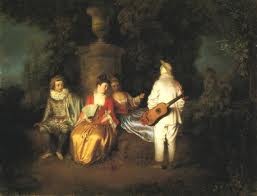 |
 |
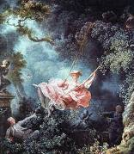 |
| La Partie carrée Antoine Watteau |
Diana at Her Bath Antoine Watteau |
The Swing Jean-Honore Fragonard |
Before the middle of the eighteenth century, the Protestant Reformation had caused hostility to religious art, and not much art was created in England. The artist who was largely responsible for increasing the prestige of English painting was Sir Joshua Reynolds. He was successful in painting the portraits of the aristocracy and became the undisputed leader of his profession.
Thomas Gainsborough was Reynolds's equal as a portrait painter, although Gainsborough maintained that he preferred landscapes. The colors in Gainsborough's paintings sparkle when viewed from a distance. Viewers are surprised when they move closer to discover the sketchiness of his painted surfaces. Gainsborough created this effect by sometimes painting with brushes attached to handles measuring as long as six feet. Using these-enabled him to place himself at the same distance from his model and his canvas.
Another famous eighteenth-century artist was William Hogarth. Many of his paintings were picture stories told in several scenes. They revealed the immoral conditions and foolish customs of his time.
Art works
The outstanding Italian artist of the eighteenth century was Giovanni Battista Tiepolo. Constantly commissioned to make paintings, he created ceiling and wall frescoes filled with airborne figures and fleecy clouds. In his studies for these frescoes, he used broad sweeps of light values over the barest suggestion of chalk rendering to suggest three- dimensional forms. Francesco Guardi, brother-in-law of Tiepolo, is the best-known member in a family of Venetian artists. He is famous for his pictures showing various views of Venice. Guardi's drawings are free and expressive. They suggest rather than describe, hint rather than declare.
Canaletto, another Venetian artist, used canals, churches, bridges, and palaces as subjects. As in many of Canaletto's works, the subject is seen from a distance in order to include as much of it as possible. Even though Canaletto didn't communicate much feeling in his work, during his lifetime he was Italy's most popular artist.
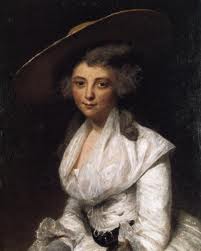 |
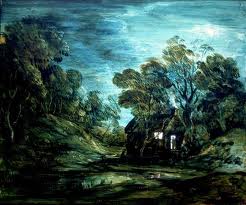 |
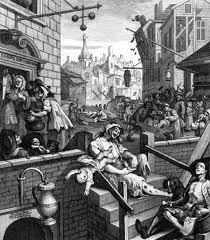 |
| Mary Bingham Sir Joshua Reynolds |
Wooded Moonlight Landscape Thomas Gainsborough |
Gin Lane William Hogarth |
The outstanding Italian artist of the eighteenth century was Giovanni Battista Tiepolo. Constantly commissioned to make paintings, he created ceiling and wall frescoes filled with airborne figures and fleecy clouds. In his studies for these frescoes, he used broad sweeps of light values over the barest suggestion of chalk rendering to suggest three- dimensional forms. Francesco Guardi, brother-in-law of Tiepolo, is the best-known member in a family of Venetian artists. He is famous for his pictures showing various views of Venice. Guardi's drawings are free and expressive. They suggest rather than describe, hint rather than declare.
Canaletto, another Venetian artist, used canals, churches, bridges, and palaces as subjects. As in many of Canaletto's works, the subject is seen from a distance in order to include as much of it as possible. Even though Canaletto didn't communicate much feeling in his work, during his lifetime he was Italy's most popular artist.
Art Works
1750-1880
Neoclassicism originate in Rome and spreads in reaction to the excesses of Baroque and Rococo. Scenes from Roman history become en vogue and copies of antique art are all the rage. The French Revolution is captured by artists like Jacques Louis David, while across the ocean, colonial American painters put oil to canvas as Neoclassical buildings are constructed. Neoclassicism was a reaction to the earlier Baroque and Rococo styles. Rejecting traditional subject matter, artists turned to the classical art of ancient Greece and Rome and the Renaissance masters for their inspiration.
Among the foremost artists to work in this new Neoclassic style were Jacques-Louis David and Jean A. D. Ingres. Ingres is considered to be one of the great drafters of history. He was forced for a time after the defeat of Napoleon to make a living by drawing pencil portraits of wealthy English tourists. Ingres developed a style marked by a keen eye and sensitivity for line.
Theodore Gericault is usually credited with creating the Romantic style, which emphasized a spontaneous approach to drawing and painting. At Gericault's death, Eugene Delacroix assumed the leadership of the Romantic movement. A trip to north Africa in 1832 exposed him to the colorful life of the Arabs. One of his drawings, showing an Arab being attacked by a lion, clearly illustrates Delacroix's ability to capture furious action. Neoclassic artists such as Ingres and David turned to classical Greek and Roman artists and Renaissance artists for their inspiration.
Art works
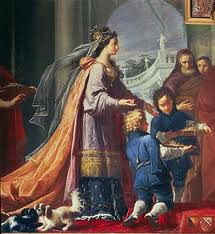 |
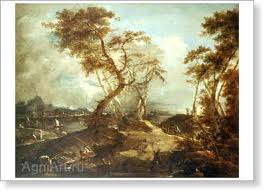 |
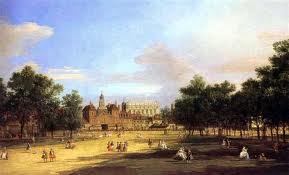 |
| Queen of Sheba Giovanni Battista Tiepolo |
Landscape Francesco Guardi |
Old Horse Guards Canaletto |
1750-1880
Neoclassicism originate in Rome and spreads in reaction to the excesses of Baroque and Rococo. Scenes from Roman history become en vogue and copies of antique art are all the rage. The French Revolution is captured by artists like Jacques Louis David, while across the ocean, colonial American painters put oil to canvas as Neoclassical buildings are constructed. Neoclassicism was a reaction to the earlier Baroque and Rococo styles. Rejecting traditional subject matter, artists turned to the classical art of ancient Greece and Rome and the Renaissance masters for their inspiration.
Among the foremost artists to work in this new Neoclassic style were Jacques-Louis David and Jean A. D. Ingres. Ingres is considered to be one of the great drafters of history. He was forced for a time after the defeat of Napoleon to make a living by drawing pencil portraits of wealthy English tourists. Ingres developed a style marked by a keen eye and sensitivity for line.
Theodore Gericault is usually credited with creating the Romantic style, which emphasized a spontaneous approach to drawing and painting. At Gericault's death, Eugene Delacroix assumed the leadership of the Romantic movement. A trip to north Africa in 1832 exposed him to the colorful life of the Arabs. One of his drawings, showing an Arab being attacked by a lion, clearly illustrates Delacroix's ability to capture furious action. Neoclassic artists such as Ingres and David turned to classical Greek and Roman artists and Renaissance artists for their inspiration.
Art works
 |
 |
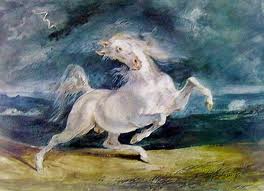 |
| Napoleon Jacques-Louis David |
Jean A. D. Ingres |
Frightened Horse Eugene Delacroix |